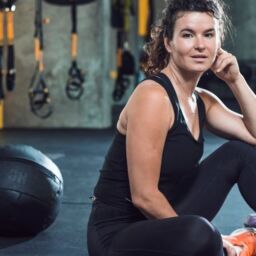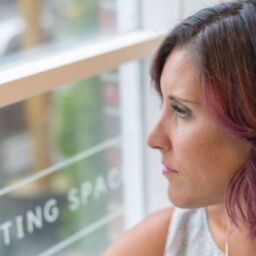
About the Podcast:
Every day our amazing brains automatically and subconsciously collect evidence from the world around us. They collect evidence of what is and isn’t safe, what works and what doesn’t, and what’s important and what’s not – all to help us survive and navigate the world.
Our brains are better and faster at collecting negative evidence than positive, though, and the over-collection of negative evidence often causes us to believe things that aren’t useful. What, if anything, can we do to change that?
In this episode you’ll learn one of my favorite self-coaching tools you can use to override your brain’s default evidence collection process. This tool is incredibly powerful, universally applicable, and simple to use. Listen in to learn the four-step process that can help you improve any area of your life.
What You’ll Learn:
- Why your brain automatically collects evidence and why it favors negative evidence over positive
- Examples of how your brain sometimes misinterprets evidence
- Kinds of evidence you can collect and how you can collect it
- Four-step process you can use to override your brain’s default functioning when the default functioning isn’t serving you
- Tips for using the tool in various situations
- How NOT to use the tool
- 20 helpful beliefs you might want to collect evidence for
Featured in the Episode:
- Facilitating Learning with the Adult Brain in Mind – Buy it on Amazon | Read Chapter 1 for free
- “20 Helpful Beliefs” PDF
- “7 Lies of Perfectionism” cheat sheet
- Connect with me on Instagram and Facebook
Does any of this sound familiar?
- You’re a smart, accomplished woman with advanced degrees and certifications.
- You’re detail-oriented, and you pride yourself on doing quality work.
- You have years of experience and think you should feel confident in what you do.
Despite all of that:
- You feel insecure speaking up in meetings and presenting to others.
- You hold back sharing ideas or asking questions in meetings because you’re worried what others will think of you.
- You obsess over details and worry about getting everything “just right.”
- You find yourself constantly reviewing and tweaking your work to make it a little better.
- You feel anxious and stuck when you can’t get something “just right” or when you’re not sure what “just right” is.
If that sounds like you, I want you to know you’re not alone.
If you’d like to feel more confident in your career and personal life, my FREE “Feel More Confident” cheat sheet can help. You’ll learn 3 simple steps to start feeling more confident today.
If you’d like even more help, sign up for a FREE confidence booster call with me. We’ll meet on Zoom, and in just 45 minutes, I’ll identify one of YOUR confidence blockers (it’s not the same for everyone), and I’ll tell you one thing you can do to fix it. Then, if you’re interested, I’ll share information about my one-on-one confidence coaching program. Whether you sign up or not, you’ll leave the call knowing one thing you can do to feel more confident.
Confidence doesn’t come from degrees, certifications, accolades or experience. It’s a learnable skill, and I can teach you how to have it for the rest of your life.
Schedule a free confidence booster call to get started today.
Full Episode Transcript:
Welcome to the Perfectionist Professional Woman podcast. This is episode eight, “Collecting Evidence for What You Want.”
I’m Keri Martinez. I’m a wife and mother of three children and three bonus children. I’m also a certified life coach and a member of the Church of Jesus Christ of Latter-day Saints. For a good portion of my life, I equated perfection with happiness and success. I thought that striving to be perfect and do things perfectly was the key to feeling happy and to being successful. I’ve since come to realize that perfection isn’t necessary to achieve either one of those–quite the opposite, in fact–and that has made such a difference in how I think, feel, and experience life. So if you’re a professional woman and you’d like to know how to release perfectionism so you can trade self-doubt for self-confidence, stop beating yourself up, and start enjoying your life more, then come with me. Let’s do this together.
Hello, and welcome back. In this episode of the podcast, I’m going to talk to you about one of my favorite self-improvement, coaching, and mind management tools. This is one of my favorites because it is incredibly powerful, it’s universally applicable, and it’s very simple to use.
I actually talked about this tool on last week’s episode about slow progress. And because it is so powerful and can be used in any area of your life – I mean, I’ve tried to come up with areas it wouldn’t be applicable and I haven’t been able to yet – so because of that I decided to devote an entire episode to this tool. My hope is that by the end of this episode you’ll see the potential for this tool to impact your life for the better and you’ll want to try it out.
So I’m going to explain what the tool is and how to use it, and I’ll give you a few examples and ideas to get you thinking about how you could use it in your life.
Sound good? Let’s do it!
So what is this amazing tool? It is – drum roll, please – collecting evidence for what you want in life.
Now, our brains collect evidence all day long every day. They do this without us even being consciously aware of it, and they do it to help us survive and give us a sense of stability. In the book Facilitating Learning with the Adult Brain in Mind, the authors talk about how our brains want to be right and they crave certainty. Our brains do not like ambiguity, because not knowing something could potentially be fatal. If I don’t know what’s causing the rustling in the grass over there or what’s creating that big shadow around the corner, I could die.
In addition to evidence about our immediate physical safety, our brains also automatically collect evidence about things that impact how we function in the world. They collect evidence about things like what a family is supposed to look and act like, what bodies should look like, right and wrong ways to make money, how much money is needed to be happy, how to succeed and who is able to succeed, what defines success, how people should treat each other, good and bad uses of time, money, and other resources, and on and on. It is normal and healthy that our brains do all of this.
So if our brains automatically do this, then why am I calling it a tool? Well, the automatic process is not the tool. That’s not what I’m talking about. The tool is consciously doing it for our benefit. It’s overriding the default functioning when that default functioning isn’t serving us.
You see, in default mode, our brains are faster and better at collecting negative evidence than positive. This is to protect us because, “as they say, the tiger has to be right once, but you have to be right all the time” (Facilitating Learning with the Adult Brain in Mind, p. 17). We want our brains to be aware of potential danger and to collect evidence about things that could hurt or kill us, but sometimes our brains collect evidence that ends up hurting instead of helping us.
For example, if we’re punished for making messes, making mistakes, or failing, our brains collect evidence that messes, mistakes, and failure are bad. If someone abuses or injures us, our brains might collect evidence that people are cruel or the world isn’t safe. If we experience bullying, racism, sexism or some other kind of prejudice, our brains might collect evidence that there’s something wrong with us or that life isn’t fair. If we grew up in a family where one or both parents worked long hours, came home exhausted, and never seemed to have enough money, our brains might collect evidence that it’s hard to make money and we will never have enough.
We want our brains to be watchful and collect evidence about potential dangers or threats. But, if we realize that certain evidence our brain has collected isn’t helping or serving us, we can intentionally look for and collect different evidence. And that’s where the tool comes into play. So let’s talk now about how to use it. It’s basically a four-step process.
Step one is to ask yourself, “What am I believing right now?” Step two is to ask, “Do I want to continue believing that?” Step three is deciding on purpose what you do want to believe. And step four is to start looking for evidence to support your new desired belief. The evidence you collect can be things like stories, anecdotes, parables, and analogies, and they can be from your own life or other people’s lives. Evidence from your own life can be especially powerful, but sometimes that’s not available to you. If you don’t have any evidence from your own life, it’s totally fine to borrow from someone else’s. And don’t worry if you have to stretch yourself and your brain to find evidence, especially when you’re first starting, because whatever you task your brain to look for, it will find. It’s almost magical how that happens. But just trust the process and have fun with it!
Let me give you an example of how I did this to help you visualize how this works.
For years, I operated under the belief that I could not be on time to save my life, and my brain had plenty of evidence to back that up. I was late to work and a lot of meetings at work. I was late getting up in the morning. I was late to doctor appointments and appointments with friends and family. I was late to church. I was late getting off work and getting home. I was late picking up my kids. If I was on my way somewhere and got delayed by traffic, I’d use that as further evidence I couldn’t be on time.
Then one day a couple of years ago, it dawned on me that it wasn’t serving me to believe I couldn’t be on time to save my life, and it wasn’t benefitting me to continue focusing on the mountain of evidence I had to support that belief. So I went through the four steps of using this tool. Step one, I identified what I was believing (that I couldn’t be on time to save my life), and step two, I decided I didn’t want to believe that any more. Step three, I decided I wanted to believe I could be on time and step four, I started looking for evidence of that.
Now, it was hard at first, because my brain was very well practiced at collecting evidence about my inability to be on time. But I looked for and acknowledged even small evidence of me being “on time.” I noticed I was “on time” paying bills each month. I was “on time” filling up my car with gas because I never ran out. I was “on time” doing laundry because we always had clean clothes to wear. I was “on time” buying groceries because we always had food to eat. I was “on time” usually returning library books.
I also started looking for evidence from my past and realized I had been “on time” turning in assignments all through school. I had been “on time” turning in college applications and showing up to take exams like the SAT and ACT and AP tests. I had been “on time” getting to the hospital before each of my children were born because none of them were born in the car on the side of the road.
Then anytime I got to an appointment, meeting, activity, church, etc. on time, I acknowledged it to myself and I’d say something like, “See, you can be on time. Good job!” I confess, it felt a little silly, I’m not going to lie, but it helped!
Now, am I still late sometimes? Yes, but much less often. And when I’m late now, my brain still tries to bring up the old evidence, the evidence that I’m incapable of being on time. It’ll offer me thoughts like, “Yup, late again. Just like all those other times.” But when that happens, instead of just accepting the proffered old evidence, I now do two things: 1) I remind myself, “No, no, no. We’re not looking at that evidence anymore because it’s not helpful,” and 2) I tell myself, “Just because you weren’t on time this time doesn’t mean you can’t be next time.” It’s all little stuff – little pieces of evidence, little reminders to myself – but it has made a big difference.
Let’s take a look at another example based on something that comes up again and again for me and most of my clients – insecurity, self-doubt, and lack of confidence at work. Remember step one is to identify what you’re believing, and if you’re worried about speaking up in a meeting, for example, you might believe you’re not as experienced or knowledgeable as others or that you’re going to mess something up or you’re going to say something stupid and others will think you’re stupid. So let’s look at this last option that you’re going to say something stupid and others will think you are stupid. We’ve identified the belief, the current belief. Step two is do you want to continue believing that? Now what I find interesting here is that most people, myself included, will say, “No, of course I don’t want to keep believing that!” but they’ll then give all kinds of reasons why they have to keep believing it. They’ll present lots of evidence to back up the belief – examples of previous times they’ve said dumb things or messed things up or frozen. They will fight to keep the painful belief. Now, they don’t consciously realize they’re doing this. They think they’re just stating facts of life. So, just know that if you catch yourself doing the same thing – if you realize you’re believing something you don’t want to but don’t think anything else is possible to believe because your brain just gives you a ton of evidence to support your current belief – the best thing you can do is pause and take a breath. Sometimes it even helps to say “stop” out loud to yourself if your mind is really spinning in the thoughts of the old evidence, but you need to do something to interrupt your brain’s default processing.
From there, remind yourself you don’t want to keep believing you’re going to say something stupid and others will think you’re stupid. Remind yourself you don’t want to fight to hold on to that painful, limiting belief. You want to believe something different. Step three is considering what you do want to believe instead. I don’t suggest you go to the complete opposite belief that you’re going to say brilliant things and everyone will think you’re brilliant for a couple of reasons. First, you’re not always going to say brilliant things. You’re going to say things that sound unpolished, mediocre, less than brilliant and even dumb sometimes because you’re human and that’s what humans do. Second, no matter what you say or do, you can’t control what others think about you. Our brains like to think if we do or say the “right” things, people will like us, admire us, think we’re smart, think we’re competent, etc., but that’s just not the case, so really it’s a waste of good mental and emotional energy to try.
I think a better belief would be something like, “I will be okay no matter what others think about me because their opinions don’t impact my worth. I will be okay because I will always have my own back.” Now just stop and think here for a minute. How confident would you feel if you really believed that?
But let’s say it’s too much of a stretch, too big of a leap for your brain to believe that? What if your brain just rejects that idea outright? In that case, you can start with something that’s easier for your brain to buy into and then gradually ladder up your beliefs. For example, you could start with something like, “I will survive if I say something dumb” or “Everyone messes up sometimes, and I will make it through if I do.”
I find it can be really helpful to start with beliefs that include “I’ll survive” or “I’ll make it through” because your brain already has evidence to support those. Obviously you’ve survived and made it through before because you’re still here, and reminding your brain of that can help your brain calm down so you can then collect additional evidence.
Once that belief is solid, you could ladder up to a belief like, “Smart people sometimes say dumb things, and that’s okay” or “I will be okay if I mess up or say something dumb.” Can you see how believing you’ll be okay is a step up from believing you’ll survive? And from there you could ladder up to the belief “I’ll be okay no matter what others think about me because their opinions don’t impact my worth. I’ll be okay because I will always have my own back.”
So, one of the things I want to believe that I’m collecting evidence for now is that failure can be helpful and can be a good thing. I’ve been working on this for a couple of years, and like the example I shared previously, I had to ease into it. When I first started looking for evidence, I wanted to believe it, but my brain completely rejected it. So I decided to ladder up to it. I started with the idea that failure is not a death sentence, that it’s not the end of the world, which is similar to the “I’ll survive” or “I’ll make it through” idea I talked about before. That was more believable to me, and therefore easier for me to collect evidence of. Once I felt solid in that belief that failure isn’t a death sentence, I moved to collecting evidence that failure isn’t a problem – so see it’s a slight step up from what I was believing before – and then from there to the idea that failure can be helpful.
I mentioned before that the evidence you collect doesn’t have to be from your own life to be effective. It also doesn’t have to come from the same area to be effective. For example, another belief I want to strengthen is that little things create big results. I want to believe this more in my business, but I’m not limiting my evidence collecting to that one area. I’m collecting evidence wherever I find it, and one place I’ve found evidence is in cleaning my shower.
In our previous house, the shower in my bathroom had a privacy film on it. That privacy film concealed the hard water deposits somewhat, and because of that, I often didn’t squeegee the glass after I’d shower. Eventually the hard water deposits built up enough that I could see them, but they were really hard to get rid of at that point. When we moved into our current house, the shower in my bathroom didn’t have a privacy film. It was clear glass, and I wanted to keep it that way, so I committed to squeegeeing the shower after every use. It’s a little thing, right? Little things are easy to do, but they’re also easy not to do, because we tell ourselves they’re too little to matter. Individually they don’t, but collectively, over time, they do. And I’ve squeegeed that shower every day, every time I’ve used it (and my husband has, too), and our glass is just as clear as the day we moved in over 10 years ago. That is powerful evidence for me that little things can create big results.
I’m going to give you suggestions of some other beliefs you might want to collect evidence for, but before I do that, I want to give a quick caveat. Please remember that this tool is meant to help you grow and evolve into your highest self. It is not meant for you to use it against yourself or against anyone else. I am not suggesting you use it as a way to ignore problems – in your own life or the world in general. I’m not suggesting you use it to convince yourself that staying in an abusive or harmful situation is okay or good. And I’m not suggesting you should use it to convince yourself to believe something you don’t want to believe.
I have no desire to change my beliefs that human trafficking is evil and abuse in any form is wrong. I don’t want to change those beliefs just so that I can feel better about the world I live in. I want to feel sad and grieved and angry when I hear about those things because I want to keep that part of my humanity. I want to feel empowered to fight against them. I don’t want to feel hopeless about them, though, because that disempowers me. Hopelessness makes it more likely I’ll give up and not do anything to combat them. So I choose to believe those things are wrong and terrible, but I don’t choose to believe they’re overwhelming or that there’s nothing I can do about them. I choose to believe what I think will help me act in line with my highest self, and that’s the yardstick I recommend you use when applying this tool. Don’t abandon a current belief or look for evidence to support a different belief because you think you should or shouldn’t believe something. Ask yourself if your current belief supports you in becoming your highest self, and if not, what new belief would support you in that?
Okay. To wrap up, here are 20 beliefs you might want to start collecting evidence of. As I list each one, I’d invite you to consider how your life might be different if you believed it. Which of these might serve or benefit you to believe them?
- The universe is always working in my favor.
- Things happen for me, not to me.
- It was meant to happen the way it did.
- I am doing enough.
- I always have enough.
- Money is easy.
- It’s amazing to be alive right now.
- Everyone is doing the best they can.
- I CAN do hard things.
- Everything is figureoutable. (I got that one from Marie Forleo.)
- Little things create big results.
- Effort matters more than talent.
- There is plenty of time.
- Failure is how we get to success.
- Learning what not to do can be just as valuable as learning what to do.
- Worry serves no purpose.
- I matter.
- I am exactly as I should be.
- I can make a difference.
- I am capable of great things.
If you’d like a list of those 20 beliefs, just head to the show notes, and I’ve created a PDF that you can download for free on my website.
Thanks for listening to this episode of the Perfectionist Professional Woman podcast. To see show notes and a transcript, head over to kerimartinez.com/ podcast. That’s k-e-r-i-m-a-r-t-i-n-e-z dot com forward slash podcast. And while you’re there, click the link to download my “7 Lies of Perfectionism” cheat sheet so you can see which lies you’re believing that are holding you back. If you have any questions or comments about the episode, feel free to reach out to me on Instagram or Facebook. I’m @kerimartinezcoaching on both.
Have a beautiful week – ciao for now!














